Starting from 3,000 yuan in name?Famous journals have revealed a number of thesis authors falsely
Author:Scientific network Time:2022.07.28
Wen | Feng Lifei
Dental experts publish papers in the field of mechanical engineering. Experts in the medical, economic, and financial fields publish related papers of fluid mechanics ... Can normal scholars really do research in this way?
Recently, the well -known opening of the journal "Scientific Reports" has expressed "editing concern" for the two papers. The reason is mainly the author's identity.
The reporter of the China Sciences found that most of the authors of the two articles came from Indonesia, Iran, and Russia, and one of them also involved a Chinese work. At the same time, both articles have the professional field where the author is located with the theme of publishing the paper, "Wind and horses and cows." A few months ago, similar reasons also caused another paper to be withdrawn.
A study published by ANNA Abalkina, a sociologist in Berlin, Germany, mentioned in a study in March this year that there is a brokerage company specializing in the signature of the dissertation according to the signature location and the impact factor of the journal. The cost ranges from 1700 yuan to nearly 50,000 yuan. The position of the first author is usually more expensive, with a starting price of 3,000 yuan.
According to reports, the territory of such multinational businesses has been expanding in recent years, and related papers have penetrated to many large academic publishing institutions under the journals, making journal editors invincible.
Author's identity fraud: two articles are concerned, one article is withdrawn
According to its official website, the "Science Report" is the fifth largest possibility of the world, and it was cited more than 690,000 times in 2021. However, some academic whistlers believe that the journal may have been followed by institutions of "buying and selling authors."
On July 14, the "Science Report" expressed concern about a paper on the study of nanotoscopic values (hereinafter referred to as A). The agency listed by the communication author Meisam Babanezhad is the artificial intelligence department of the School of Mechanical Engineering, the University of Azad, Iranian Azhad.
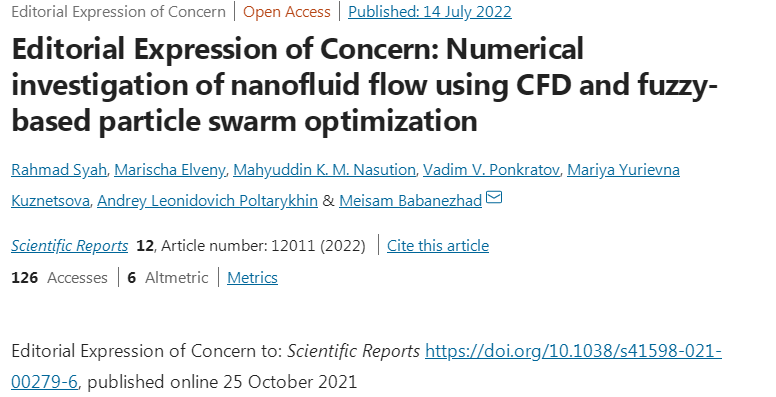
A article A on July 14 was expressed. The first author of the paper comes from the Data Science and Computer Intelligence of the Mianlan Regional University in Indonesia; the second and third authors come from the University of Beimen's University of Computer. The fourth and sixth authors are from the field of medical, economic and financial in Russia. The author comes from Iran.
Although Azard University is easy to retrieve, the so -called Sandman Industrial Strategy Company does not seem to have any clues about its existence on the Internet.
Sandman is just the name of an Iranian area. The "Request Observation" website found 13 "Sandman" related entries in the publishing database, including the chapters and 11 journal papers of the two books.
Among them, Babanezhad is the common author of all these journal papers. What is surprising is that the correspondence address of his website on ORCID (open researcher and contributor identification code) is Vietnam's Duy Tan University, not Iran's relevant agencies.
Several other authors of the paper are also noticeable.
For example, Mariya Kuznetsova is a doctor at the First Medical University of Moscow's National Shenduof; Andrey Leonidovich Poltarykhin is from the field of agricultural management in the Putlehanov Economics University of Moscow; Vadim V. Ponkratov is from the University of Russia. They have never published any papers related to nanomang and particles in the past.
In this regard, Rafal Marszalek, editor -in -chief of the Science Report, said, "Some readers contact us and expressed their concerns about the content of some authors. Edit concern. "
This statement warns the reader: A text author has signs of irregular identity, and some authors' professional knowledge that does not match the theme of thesis has attracted attention. Although the author provides an explanation of other authors during the submission of the paper, it has not recorded the contribution of all authors in detail.
Regarding the editorial concern, Babanezhad and 4 other A text authors disagree, while Kuznetsova and Poltarykhin did not respond to the letter edited by the journal.
It is worth noting that in February of this year, members of the A text team published another paper (hereinafter referred to as the Book of B) in the "Scientific Report". Essence
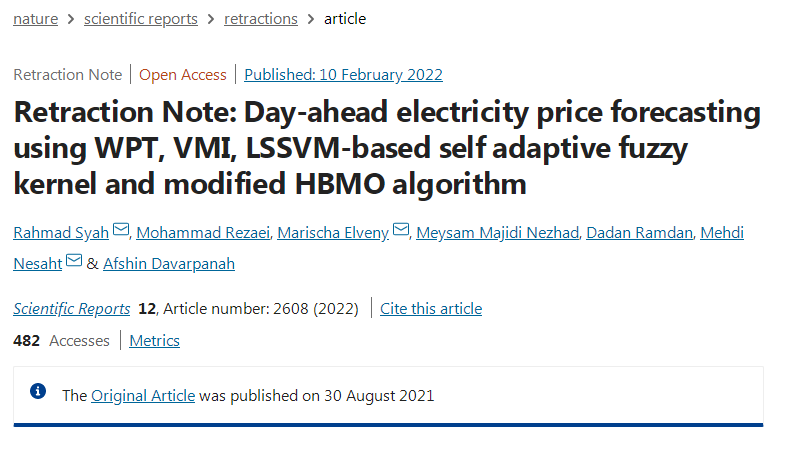
On February 10, 2022, article B was withdrawn
The works of text B and A are both Rahmad Syah from the data science and computer intelligence field in Mianlan University.
Not only that, on July 5th, the "Science Report" was a study of the use of molecular dynamics to simulate carbon nanoparticles to improve conventional concrete performance (hereinafter referred to as C), and also expressed similar concerns to text A.
The first and communication authors of the article are Zhao Liang, a teacher at the School of Civil Engineering and Engineering of the Yangtze River Teachers College. Other authors are from mechanical engineering or computer in Iran, Indonesia and Russia. Among them, the fifth author Pavel Kamenskov is a dentist at the First National Medical University of Moscow.
After receiving the editorial concerns, the author of the C -text communication author Davood TOGHRAIE agreed to the editor's concern, and the other authors did not respond.
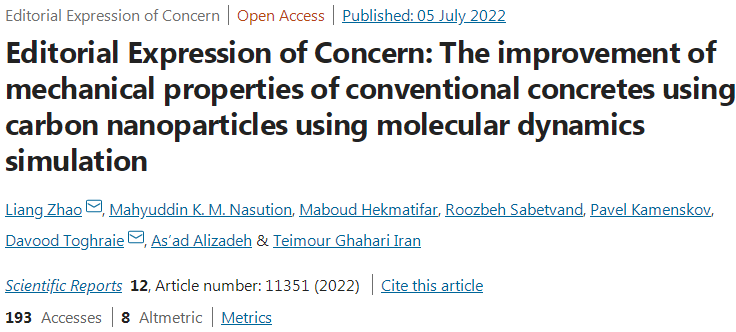
On July 5th, the concern C, which was expressed concerned, "experts from dentistry published papers in the field of mechanical engineering, and experts from the economy, finance and medical field published a papers of fluid mechanics. Far. Don't you think this seems to be the author of the author? "The academic counterfeit" detective ", Alexander Magazinov at the School of Moscolovocho Technology.
The Scientific Report did not respond to this view. However, the "Revisibility Observation" stated that many recent clues explained that these articles involved were related to such academic fraud.
Starting from 3,000 yuan, the dissertation name is made into a business
"Author's identity trading" referred to by Magazinov is not targeted.
In 2019, "Revised Observation" revealed a Russian brokerage company, claiming to be an author of more than 10,000 researchers in more than 2000 papers. Subsequently, Kori Wei'an, a professional information consulting service agency, issued a letter of stop, but this did not have any impact on its business.
Since then, Anna Abalkina, a sociologist in Berlin University in Germany, has been paying attention to the website (www.123mi.ru) operated by the company. In a study published in the pre -printing server in March this year, she analyzed the company's "prosperity" business.
By analyzing more than 1,000 advertisements published on the website, she found that at least 419 advertisements may match the manuscripts that have appeared in dozens of different journals later.
More than 100 of them are published in 68 journals operated by well -known publishers, most of which are professional publications.
Abalkina said that in the recent contract signed by the website, the number of Russian authors exceeds other countries. The author's identity price depends on the position of the author's list and the impact factor of the journal. The cost ranges from 1,700 yuan to nearly 50,000 yuan. The location of the first author is usually more expensive and the price starts from 3,000 yuan. Based on relevant statistics, ABALKINA estimates that from 2019 to 2021, the company has earned more than 43 million yuan.
The "Science" magazine has contacted the company many times, which said that its headquarters is located in Moscow and has offices in Ukraine, Kazakhstan and Iran. Its homepage shows that its editor -in -chief is KSenia Badziun, Ukraine.
Recently, the "Request Observation" also found two other institutions similar to Russian companies: a scientific publisher SIA, a scientific publisher in Iran's website Teziran.org and Latvia. They all claim that they can sell the authors and provide ready -made publishing services with various themes.
The country where the author of the scientific report involved in the "Science Report" is also surprisingly similar, including Russia, Iran, and Indonesia. Some experts believe that there is probably the "thesis factory" where the author is traded.
So, how does the author's identity buy and sell the journal reviewer?
Kori's database Web of Science editor NANDITA Quaderi believes that its operating strategy may use a vulnerability in the publishing process, that is, the author allows the author to add other people's name after the manuscript is accepted. This has caused some authors to inform the author's identity to buy and sell websites after receiving the paper manuscript, and sell the right to sign the dissertation.
However, some experts pointed out that some bottomless plunder journals may also participate in the papers. The above -mentioned Russian website stated naked: the website has shared related income with some journals to ensure that it is involved in the plan.
As Abalkina said, the scale and shamelessness of this operation are unimaginable. What is worried about more scientists is that these fake authors' identities will destroy the public's confidence in science.
Invincible, unsatisfactory industries
In response to the authority of the author, some journal publishers said that they are investigating some papers that attract attention and strengthen the review of the publishing process.
"'Thesis factory' is not good for the research and publishing industry." Chris Graf, the research integrity director of Spelinger, said that in addition to investigating individual cases and withdrawal of problems, they have been reviewing the publishing process and technically technically Investment to help identify the behavior of trying to manipulate its publishing system.
The Publishing Ethics Commission and the Editorial Committee of the International Medical Journalism also issued guidance to help journal editors from buying the author's identity. They suggested that the editor should ask the authors who want to add their names after submitting the manuscript to provide their respective contributions and signature licenses of all signed authors.
At present, let the journal editors still challenge the authors who have related fraud before the publication of the paper.
Abalkina said that in order to make the transaction more hidden, many thesis factories have confidential terms. Even if some thesis has the status of the author's identity, the relevant authors will not sue.
In addition, in order to avoid the review of editing, international publishers involved in the papers have adopted a strategy, that is, no longer repeatedly published a document for the same journal, which makes it difficult for editors to detect some abnormalities.
But she said that there are some clues to find these behaviors, such as the author of the paper from multiple unrelated academic departments, which means that they are unlikely to cooperate in reality.In addition, the author's professional and the theme of the paper manuscript is also one of the clues.Relevant information:
https://retractionwatch.com/2022/07/19/papers-scientific-reports-nd- their-expressions--confern-raise-questions/25271125271
https://www.nature.com/srep/about
https://www.nature.com/articleS/S41598-022-16513-8
https://www.nature.com/articleS/S41598-022-06630-9
https://www.nature.com/articleS/S41598-021-99616-Author-Information
https://retractionWatch.com/2021/09/07/introducing-two-size-claim-sell-authorships- on-scientific-papers/
https://www.science.org/Content/Russian-website-)
https://arxiv.org/ftp/arxiv/papers/2112/2112.13322.pdf
Capture | Guo Gang
Cooperation: [email protected]
Submission: [email protected]
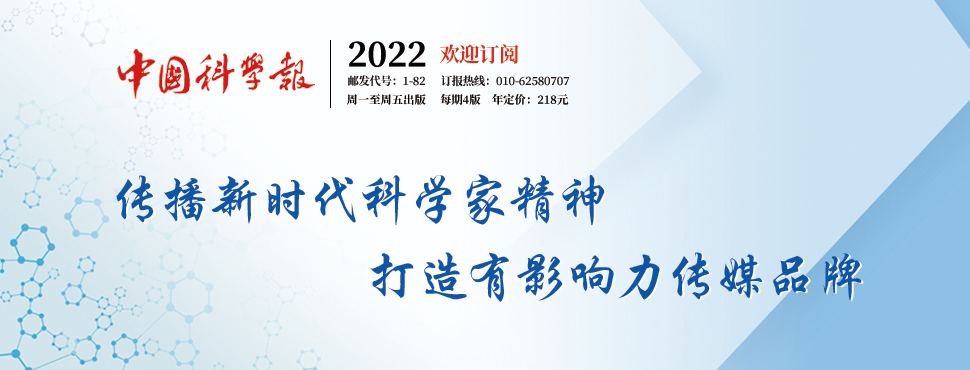
Like this article? Praise + watch support!


- END -
Examples encourage growth before the growth -Jilin Provincial Forest Fire Corps New Recruitment Cadre Training Team actively organizes the "Advanced Typical Classroom" activity
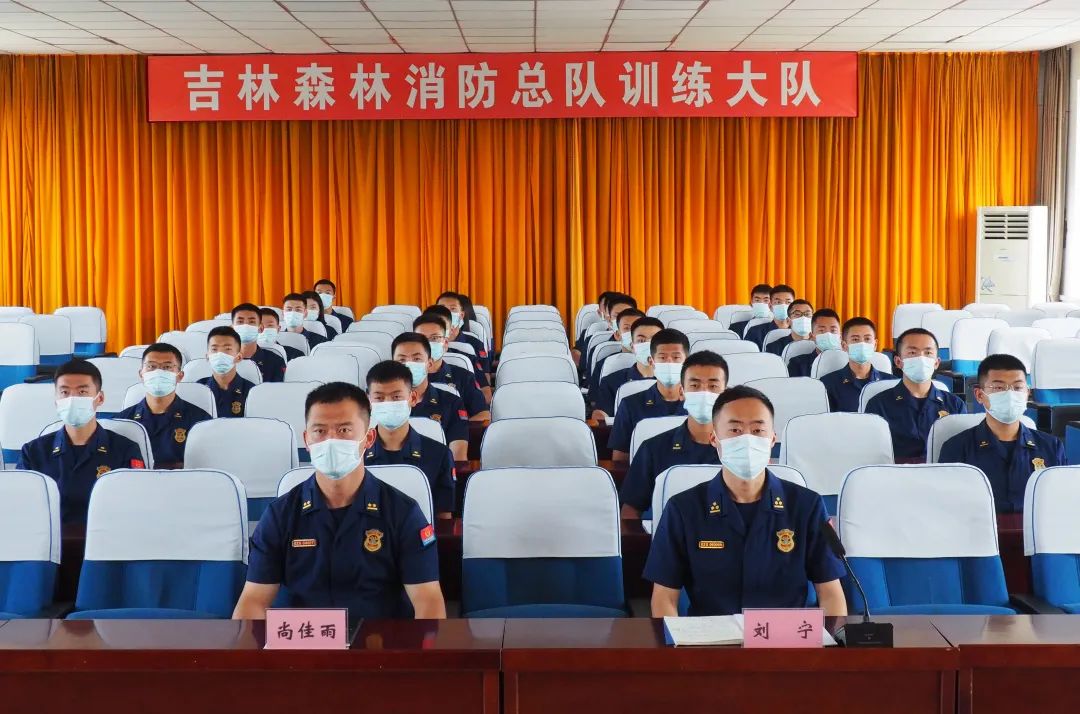
In order to further educate cadres and students to improve their first job ability...